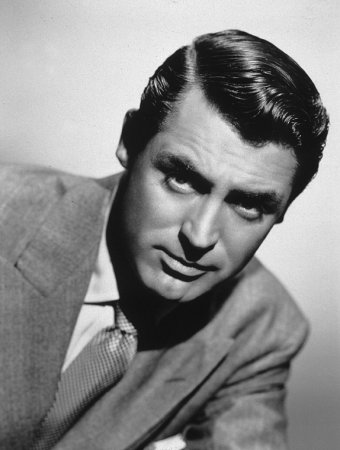|
Cary Grant
Scroll down for movie list.
Biography from Leonard Maltin's Movie Encyclopedia:
Actor. (b. Jan. 18, 1904, Bristol, England, as Archibald Alexander Leach; d. Nov. 29, 1986.) As a teenage runaway, Archibald Leach began his lengthy show-business career as an acrobat, juggler, and song-and-dance man, touring with small troupes and playing music halls all over England. In 1920, as one of the Bob Pender comedy troupe, he came to America on a two-year tour and decided to stay. He took several other jobs (including that of lifeguard) to supplement his modest solo performing career. After several years Leach returned to the U.K., where he achieved considerable success as an engaging leading man in lighthearted stage plays. He returned to the United States late in the decade, eventually starring on Broadway and embarking on a successful tour across the country. In 1931 he made his film debut as a jaunty sailor in a Paramount short subject,Singapore Sue
Upon reaching Hollywood in 1932 he was screen-tested at the behest of Paramount studio chief B. P. Schulberg, signed to a long-term contract, and rechristened Cary Grant. (The studio's first choice was Cary Lockwood.) He made his featurefilm debut inThis Is the Night a charming, sophisticated comedy of the type that would make him a top star. The urbane, personable Grant appeared in a slew of 1932 Paramount pictures-among themSinners in the Sun, Merrily We Go to Hell, Blonde Venus (opposite the studio's top female star, Marlene Dietrich),The Devil and the Deep, Hot Saturday andMadame Butterfly-before costarring with Mae West inShe Done Him Wrong (1933), a ribald, wildly successful comedy in which West exhorted Grant to "come up some time an' see me."
Over the next few years Grant tackled a wide variety of starring roles in costume dramas, war films, adventure pictures, and topical comedies. He built, slowly and steadily, a reputation as one of Hollywood's most dependable leading men. His films during this period, most of them made for Paramount, includedThe Eagle and the Hawk, I'm No Angel (also opposite West),Alice in Wonderland (all 1933, in the last-named as the Mock Turtle),Thirty-Day Princess, Ladies Should Listen, Kiss and Make Up, Born to Be Bad (all 1934),Enter Madame, Wings in the Dark, The Last Outpost, Sylvia Scarlett (all 1935, on loan to RKO in the lastnamed, opposite Katharine Hepburn),Suzy (for MGM, paired with Jean Harlow),Big Brown Eyes, Wedding Present, The Amazing Quest of Ernest Bliss (all 1936, the last-named a British-made comedy),The Toast of New York andWhen You're in Love (both 1937).
He hit his stride in a string of sophisticated screwball comedies-beginning withTopper (1937)-in which he evolved the debonair, witty, uninhibited screen persona that ultimately brought him superstardom. The next several years saw Grant at his peak, alternating classic comedies (such as 1937'sThe Awful Truth 1938'sHoliday andBringing Up Baby 1940'sHis Girl Friday, The Philadelphia Story andMy Favorite Wife with similarly well-remembered dramas (1939'sIn Name Only and 1941'sPenny Serenade for which he was Oscar-nominated), adventure films (1939'sGunga Din andOnly Angels Have Wings and thrillers (1941'sSuspicion the first of his many films for director Alfred Hitchcock).
He managed to balance the same kind of mix throughout the 1940s, in the witty social comedy-dramaThe Talk of the Town (1942), the charming star vehicleMr. Lucky (1943), the energetic farceArsenic and Old Lace (1944; made in 1941), the atypically moody dramaNone but the Lonely Heart (1944, a personal favorite of Grant's, with his characterization as a Cockney drifter earning another Oscar nomination), the wartime submarine dramaDestination Tokyo (1944), the crackling romantic thrillerNotorious (1946, again for Hitchcock), the musical biographyNight and Day (1946, as Cole Porter), and such airy seemingly effortless comedies asOnce Upon a Time (1944),The Bachelor and the Bobby-Soxer, The Bishop's Wife (both 1947, in the latter as an angel in a Brooks Brothers suit),Mr. Blandings Builds His Dream House, Every Girl Should Be Married (both 1948, the latter costarring then-wife Betsy Drake), andI Was a Male War Bride (1949).
The 1950s and 1960s offered much the same, as Grant continued to charm moviegoers with a suave screen persona apparently impervious to the ravages of age.Crisis (1950) cast him in an unusual political drama;People Will Talk (1951) offered an intellectual social comedy, whileMonkey Business (1952) tried hard, perhaps too hard, to replicate the screwball comedies of the 1930s;To Catch a Thief (1955) andNorth by Northwest (1959), Hitchcock films both, were successful (almost archetypal) star-director collaborations; andAn Affair to Remember (1957) was an uneasy mix of classy comedy and hoary soapopera clichˇ-though extremely popular. His leading ladies in this period included Ginger Rogers, Deborah Kerr, Grace Kelly, Doris Day, Marilyn Monroe, Audrey Hepburn, and Sophia Loren.
AfterWalk, Don't Run (1966), a middling remake of George Stevens' 1943 hitThe More the Merrier Grant retired from the screen. He may have reasoned, correctly, that the demise of the studio system and changing audience tastes signaled the dawn of an era in which his kind of movie was passˇ. He contented himself with forays into the business world, most effectively for the Faberge cosmetics company. In 1970 Grant, who never won an Oscar in competition, received a special Academy Award in recognition of his extraordinary career. His wives included actresses Virginia Cherrill, Betsy Drake, and Dyan Cannon (who bore him his only child, daughter Jennifer, now a budding actress), and heiress Barbara Hutton. Long reticent about interviews, and unwilling to write an autobiography, he surprised many in his final years by touring the country giving informal lectures about his career, and answering questions from his many fans. He died on the eve of one such appearance in Davenport, Iowa.
OTHER FILMS INCLUDE: 1952:Room for One More (again with Drake); 1953:Dream Wife 1957:The Pride and the Passion (a rare piece of miscasting in this period turkey); 1958:Indiscreet, Houseboat 1959:Operation Petticoat (costarring Tony Curtis, who then imitated Grant, hilariously, in his subsequentSome Like It Hot 1962:That Touch of Mink 1963:Charade (an elegantly witty comedymystery); 1964:Father Goose |  |










